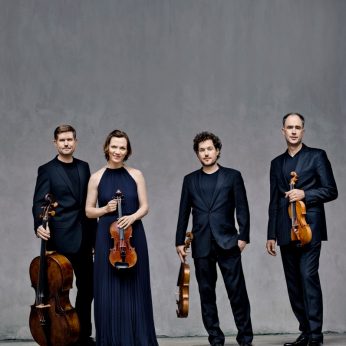Composer: Joseph Haydn (b. 1732 - d. 1809)
Performance date: 26/06/2022
Venue: St. Brendan’s Church
Composition Year: 1772
Duration: 00:23:56
Recording Engineer: Simon Cullen, Ergodos
Instrumentation: 2vn, va, vc
Instrumentation Category:String Quartet
Artists:
Signum Quartet (Florian Donderer, Annette Walther [violins], Xandi van Dijk [viola], Thomas Schmitz [cello]) -
[String Quartet]

Joseph Haydn [1732-1809]
String Quartet in G minor Op.20/3 [1772]
1. Allegro con spirito
2. Minuet. Allegretto – Trio – Minuet da capo
3. Poco Adagio
4. Finale. Allegro di Molto
The many technical innovations, which Haydn employed in his Opus 20 quartets, would be of limited interest if it were not for the considerable increase in emotional power that accompanied them. Of course the two cannot be really separated. Nevertheless, it is not surprising that Haydn’s increasing need for emotional expression led him to include two quartets in minor keys. Something he would never repeat.
The higher level of emotional intensity in these quartets has led critics to label them as part of the Sturm und Drang (Storm and Stress) movement. The symphonies he wrote at the same time are also called the Sturm und Drang symphonies. This artistic movement was a precursor of nineteenth century romanticism and it is usually thought of in literary terms. The main works were Goethe’s Sorrows of Young Werther published in 1772. The play called Sturm und Drang was first performed two years later. It is doubtful if the forty-year-old Haydn isolated in the palace of Esterhaza, kept up with the latest novels about the extremities of young romantic love. It is, of course, possible.
The G minor quartet is the strangest and most unusual work in Opus 20. Much of the music is in G major. The first movement in G minor is full of passion and drama. The sad and beautiful adagio is in G major. The finale is a triumph of humorous energy, which concludes in G major.
The first movement’s main theme is made up of two seven bar phrases. This lopsided motif dominates the movement. After repeating it, Haydn introduces a small idea based on semiquavers, which recurs throughout. The second subject consists of a number of stops and starts with Haydn eagerly exploiting the potential dissonances that the minor key provides. There is long development with a false return to the recapitulation. When the recapitulation does occur, it is followed by more development. The movement ends with a series of quiet modulations, followed by an upward scale played forte by the first violin before two quiet final chords.
The main theme of the minuet is consists of two five bar phrases. This is a mordant minor key dance which brings perhaps the first note of genuine sadness to the quartet. The beautiful calm Adagio begins with a hymn like tune. In the development, the cello accompanies the other instruments with a semi-quaver base line but as the movement continues Haydn exchanges the roles of the first violin and cello with the violin taking the semi-quaver passages. The energetic finale is in sonata form but shows you can still have fun in G minor. The quartet ends with the cello accompanying the other three instruments, but as the music fades into silence, the cello has the last word to conclude this strange and remarkable work.
David Winter
Copyright © 2025 West Cork Music. All rights reserved.
Designed and developed by Matrix Internet